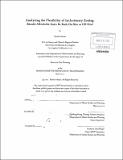| dc.contributor.advisor | Yu-Hung Hong. | en_US |
| dc.contributor.author | Alonso, Rachel (Rachel Margaret) | en_US |
| dc.contributor.other | Massachusetts Institute of Technology. Dept. of Urban Studies and Planning. | en_US |
| dc.coverage.spatial | n-us--- | en_US |
| dc.date.accessioned | 2012-10-10T15:47:22Z | |
| dc.date.available | 2012-10-10T15:47:22Z | |
| dc.date.copyright | 2012 | en_US |
| dc.date.issued | 2012 | en_US |
| dc.identifier.uri | http://hdl.handle.net/1721.1/73808 | |
| dc.description | Thesis (M.C.P.)--Massachusetts Institute of Technology, Dept. of Urban Studies and Planning, 2012. | en_US |
| dc.description | Cataloged from PDF version of thesis. | en_US |
| dc.description | Includes bibliographical references (p. 151-164). | en_US |
| dc.description.abstract | Inclusionarv zoning (IZ), a strategy first adopted by municipalities in the 1970S to create affordable housing, requires private developers of market-rate residential projects to set-aside a certain percentage of units as affordable. The original intention of IZ was to foster socioeconomic integration in the nation's suburbs - but now, the tool has been adopted in urban areas, where threats of gentrification are more of a concern. Often, developers are able to fulfill the obligations imposed by inclusionary ordinances through alternative means of compliance: namely, off-site construction of affordable units or fee payments in-lieu of construction. Such flexibility is the primary focus of this thesis: how flexible are cities in the ways developers are permitted to fulfill inclusionary requirements? What are the ramifications of flexibility? Should cities be more or less flexible? My research has found good reasons for creating flexible inclusionary ordinances, beyond just protection from legal challenges. In-lieu fees can be used as gap financing for entirely affordable projects, which can be more beneficial to residents and low-income neighborhoods from a holistic community development perspective. Usually, this also results in production of a greater number of affordable units than on-site construction would have yielded. However, flexibility should be subject to certain restrictions, with cities maintaining authority to approve the means of compliance. In-lieu fees must be set at a meaningful level, equivalent to the actual cost to develop a unit of affordable housing. Additionally, imposing geographic restrictions on off-site construction is a good way to balance the need to produce affordable housing while furthering socioeconomic integration at the neighborhood, rather than building, level. Evidence regarding the benefits of mixed-income developments for lower-income residents is still inconclusive, and the strategy fails to address the underlying structural causes that perpetuate poverty. Thus, IZ ordinances should not rigidly require on-site construction of affordable units. | en_US |
| dc.description.statementofresponsibility | by Rachel Alonso. | en_US |
| dc.format.extent | 164 p. | en_US |
| dc.language.iso | eng | en_US |
| dc.publisher | Massachusetts Institute of Technology | en_US |
| dc.rights | M.I.T. theses are protected by
copyright. They may be viewed from this source for any purpose, but
reproduction or distribution in any format is prohibited without written
permission. See provided URL for inquiries about permission. | en_US |
| dc.rights.uri | http://dspace.mit.edu/handle/1721.1/7582 | en_US |
| dc.subject | Urban Studies and Planning. | en_US |
| dc.title | Analyzing the flexibility of inclusionary zoning : should affordable units be built on-site or off-site? | en_US |
| dc.title.alternative | Should affordable units be built on-site or off-site? | en_US |
| dc.type | Thesis | en_US |
| dc.description.degree | M.C.P. | en_US |
| dc.contributor.department | Massachusetts Institute of Technology. Department of Urban Studies and Planning | |
| dc.identifier.oclc | 811144005 | en_US |
